1.1.1 Binary Number System
By : Muhamad Muhaimin Bin Minhad (B031210244)
Computers use binary digits. And some puzzles can be solved using binary numbers.
A Binary Number is made up of only 0s and 1s.
110100
|
| Example of a Binary Number |
How do we Count using Binary?
| Binary | |||
| 0 | We start at 0 | ||
| 1 | Then 1 | ||
| ??? | But then there is no symbol for 2 ... what do we do? |
| Decimal | ||||
| Well how do we count in Decimal? | 0 | Start at 0 | ||
| ... | Count 1,2,3,4,5,6,7,8, and then... | |||
| 9 | This is the last digit in Decimal | |||
| 10 | So we start back at 0 again, but add 1 on the left |
| Binary | |||
| 0 | Start at 0 | ||
| • | 1 | Then 1 | |
| •• | 10 | Now start back at 0 again, but add 1 on the left | |
| ••• | 11 | 1 more | |
| •••• | ??? | But NOW what ... ? |
| Decimal | ||||
| What happens in Decimal ... ? | 99 | When we run out of digits, we ... | ||
| 100 | ... start back at 0 again, but add 1 on the left |
| Binary | |||
| 0 | Start at 0 | ||
| • | 1 | Then 1 | |
| •• | 10 | Start back at 0 again, but add 1 on the left | |
| ••• | 11 | ||
| •••• | 100 | start back at 0 again, and add one to the number on the left... ... but that number is already at 1 so it also goes back to 0 ... ... and 1 is added to the next position on the left |
|
| ••••• | 101 | ||
| •••••• | 110 | ||
| ••••••• | 111 | ||
| •••••••• | 1000 | Start back at 0 again (for all 3 digits), add 1 on the left |
|
| ••••••••• | 1001 | And so on! |
Decimal vs Binary
Here are some equivalent values:| Decimal: | 0 | 1 | 2 | 3 | 4 | 5 | 6 | 7 | 8 | 9 | 10 | 11 | 12 | 13 | 14 | 15 |
|---|---|---|---|---|---|---|---|---|---|---|---|---|---|---|---|---|
| Binary: | 0 | 1 | 10 | 11 | 100 | 101 | 110 | 111 | 1000 | 1001 | 1010 | 1011 | 1100 | 1101 | 1110 | 1111 |
Here are some larger equivalent values:
| Decimal: | 20 | 25 | 30 | 40 | 50 | 100 | 200 | 500 |
|---|---|---|---|---|---|---|---|---|
| Binary: | 10100 | 11001 | 11110 | 101000 | 110010 | 1100100 | 11001000 | 111110100 |
"Binary is as easy as 1, 10, 11."
Position
In the Decimal System there are the Units, Tens, Hundreds, etcIn Binary, there are Units, Twos, Fours, etc, like this:
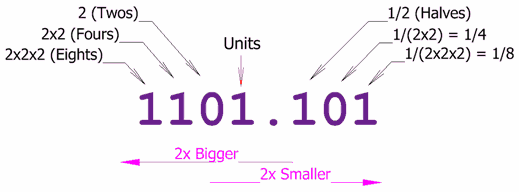 |
| This is 1×8 + 1×4 + 0×2 + 1 + 1×(1/2) + 0×(1/4) + 1×(1/8) = 13.625 in Decimal |
| 10.1 | ||||||||||||||||||||||||||||||||||||||||||||||||||||||||||||||||||||||||||||||||||
| The number to the left of the point is a whole number (10 for example) | ||||||||||||||||||||||||||||||||||||||||||||||||||||||||||||||||||||||||||||||||||
| As we move further left, every number place gets 2 times bigger. |
||||||||||||||||||||||||||||||||||||||||||||||||||||||||||||||||||||||||||||||||||
| The first digit on the right means halves (1/2). | ||||||||||||||||||||||||||||||||||||||||||||||||||||||||||||||||||||||||||||||||||
| As we move further right, every number place
gets 2 times smaller (half as big).
1.1.2 Decimal Number System
A Decimal Number (based on the number 10) contains a Decimal Point.
Place ValueTo understand decimal numbers you must first know about Place Value.When we write numbers, the position (or "place") of each number is important. In the number 327:
... and ...
And that is a Decimal Number!
Decimal PointThe decimal point is the most important part of a Decimal Number. It is exactly to the right of the Units position. Without it, we would be lost ... and not know what each position meant.Now we can continue with smaller and smaller values, from tenths, to hundredths, and so on, like in this example: 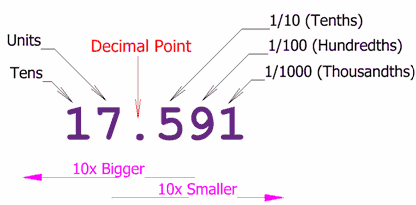
So, our Decimal System lets us write numbers as large or as small as
we want, using the decimal point. Numbers can be placed to the left
or right of a decimal point, to indicate values greater than one
or less than one. | ||||||||||||||||||||||||||||||||||||||||||||||||||||||||||||||||||||||||||||||||||
| 17.591 | |
| The number to the left of the decimal point is a whole number (17 for example) | |
| As we move further left, every number place gets 10 times bigger. | |
| The first digit on the right means tenths (1/10). | |
| As we move further right, every number place gets 10 times smaller (one tenth as big). | |
1.1.3 Hexadecimal Number System
A Hexadecimal Number is based on the number
16
16 Different Values
There are 16 Hexadecimal digits. They are the same as the decimal digits up to 9, but then there are the letters A, B, C, D, E and F in place of the decimal numbers 10 to 15:| Hexadecimal: | 0 | 1 | 2 | 3 | 4 | 5 | 6 | 7 | 8 | 9 | A | B | C | D | E | F |
|---|---|---|---|---|---|---|---|---|---|---|---|---|---|---|---|---|
| Decimal: | 0 | 1 | 2 | 3 | 4 | 5 | 6 | 7 | 8 | 9 | 10 | 11 | 12 | 13 | 14 | 15 |
Example: What is the decimal value of the hexadecimal number "D1CE"
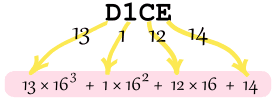
= 53,248 + 256 + 192 + 14
= 53,710
= 53,710
The Point !
Example: 2E6.A3

This is 2×16×16 + 14×16 + 6 + 10/16 + 3/(16×16)
Read below to find out why
Read below to find out why
| The number just to the left of the point
is a whole number, we call this place units. As we move left, every number place its 16 times bigger. |
|
| The first digit on the right of the point means sixteenths
(1/16). As we move further right, every number place its 16 times smaller (one sixteenth as big). |
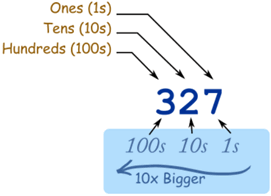

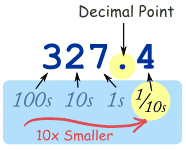
No comments:
Post a Comment